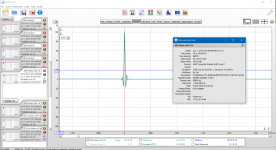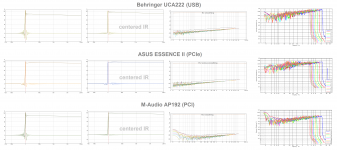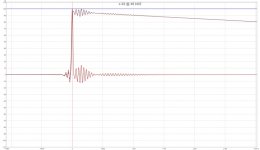Four-Audio approach is more complicated and evolved than what I propose, as this would only be a matter of running the input SRC, DSP and ouptut at 32kHz.Downsampling would be nice...
....and I take it you mean to allow for implementations in a Four-Audio type way....? Four Audio | FIR Filters: calculation power, length of impulse responses, and frequency resolution
I kinda made the same suggestion https://www.minidsp.com/forum/sugge...c-12288-mono-taps-or-lower-sample-rates#27931
I don't think 22kHz or lower would be possible with this approach as many DAC seem to limit accepted sampling rate range to 32kHz.
Indeed, but it is perfect for a ~2kHz crossover point, and you can still use a few of the available biquads to help with the filters or EQs.The plate amps do look very interesting for a small two-way....I guess as long as the crossover is high enough. For my 650Hz crossover point, 300 taps struggles a little with the slope I'd like to use. It would be nice if the plugin allowed a little flexibility here....
What version do you have?
Hi POS, I have the 250 version.
The Four-Audio approach in one miniDSP unit isn't what I meant.
I meant your approach. So we can mimic what Four-Audio does, by using multiple miniDSP units running at different sampling rates.... like you described in the link you gave previously.
The Four-Audio approach in one miniDSP unit isn't what I meant.
I meant your approach. So we can mimic what Four-Audio does, by using multiple miniDSP units running at different sampling rates.... like you described in the link you gave previously.
I see 🙂
devteam responded to your suggestion that they "might have something even better planned".
It is probably some sort of FFT convolution with a large number of taps.
Let's wait and see, but this kind of convolution invariably add some more delay, and is also more prone to implementation errors.
I wish there was an hardware/DSP convolution unit on the market powerful enough to do temporal convolution with a large number of taps without having to use decimation or FFT strategies...
devteam responded to your suggestion that they "might have something even better planned".
It is probably some sort of FFT convolution with a large number of taps.
Let's wait and see, but this kind of convolution invariably add some more delay, and is also more prone to implementation errors.
I wish there was an hardware/DSP convolution unit on the market powerful enough to do temporal convolution with a large number of taps without having to use decimation or FFT strategies...
Last edited:
What about the pro audio DSP audio interfaces? They come i several price ranges, but I don't know how powerfull the DSP's are, but some of them seems to be quite powerfull and expensive. You will ned a PC og Mac to program it, but otherwise they will work stand alone.
I wish there was an hardware/DSP convolution unit on the market powerful enough to do temporal convolution with a large number of taps without having to use decimation or FFT strategies...
I don't what decimation or FFT strategies mean, but whatever you say, ....I'm for 🙂
What about the pro audio DSP audio interfaces? They come i several price ranges, but I don't know how powerfull the DSP's are, but some of them seems to be quite powerfull and expensive. You will ned a PC og Mac to program it, but otherwise they will work stand alone.
I don't know of any pro-audio interfaces that have the FIR capability of even the smaller miniDSP units.
Pro-audio usually can't tolerate much latency, so big FIR blocks don't make a lot of sense in speaker management processors.
If you know of any, please link...very interested...
Here's a good post listing some current alternatives. The Xilica at the bottom is typical of pro units that I've seen specs for. https://www.minidsp.com/forum/opend...c-has-some-new-competition?limitstart=0#21877
Last edited:
I don't know of any pro-audio interfaces that have the FIR capability of even the smaller miniDSP units.
Pro-audio usually can't tolerate much latency, so big FIR blocks don't make a lot of sense in speaker management processors.
If you know of any, please link...very interested...
Here's a good post listing some current alternatives. The Xilica at the bottom is typical of pro units that I've seen specs for. https://www.minidsp.com/forum/opend...c-has-some-new-competition?limitstart=0#21877
I know for sure that Marani has FIR capability. And I'm pretty sure there are others.
Nice chart BYRTT,
I've stopped everything until I sort out what the sound cards are unexpectedly contributing...will report back....
16 bit Behringer UCA222/UCA202 think is great value and probably good enough as measurement interface as seen below at 48kHz.
Attachments
I don't know of any pro-audio interfaces that have the FIR capability of even the smaller miniDSP units.
Pro-audio usually can't tolerate much latency, so big FIR blocks don't make a lot of sense in speaker management processors.
If you know of any, please link...very interested...
Here's a good post listing some current alternatives. The Xilica at the bottom is typical of pro units that I've seen specs for. https://www.minidsp.com/forum/opend...c-has-some-new-competition?limitstart=0#21877
I haven't tried any myself, but here is one example
Four Audio | HD2
They sell them with frontpanel controls and without (black box), and they have an high end hifi version. They also sell the boards without connectors and chassis - but you probably should buy a lot.
Last edited:
Thanks for the replies everyone,
The Marani stuff looks nice...I had not heard of them. I see their units max out at 1024 taps per channel.
Not surprising again, given pro-audio's inability to live with much latency.
Yes, the Four-Audio HD2 is a unique solution, but very $$$$....
The UCA222/202 caught my attention for sure!
But I really need XLR / phantom power for most of the measurements I make.
Anybody measured or seen measurements for a really clean, reasonably priced, conventional mic soundcard?
After measuring the three alternatives at my disposal... behringer UMC404, UMC1820, and X-32...I've decided the x-32 is the cleanest.
Hopefully will post new speaker measurements that include the sound card's starting (negative) contribution, later today.
The Marani stuff looks nice...I had not heard of them. I see their units max out at 1024 taps per channel.
Not surprising again, given pro-audio's inability to live with much latency.
Yes, the Four-Audio HD2 is a unique solution, but very $$$$....
The UCA222/202 caught my attention for sure!
But I really need XLR / phantom power for most of the measurements I make.
Anybody measured or seen measurements for a really clean, reasonably priced, conventional mic soundcard?
After measuring the three alternatives at my disposal... behringer UMC404, UMC1820, and X-32...I've decided the x-32 is the cleanest.
Hopefully will post new speaker measurements that include the sound card's starting (negative) contribution, later today.
Try USB "Blue Microphones Icicle" XLR microphone interface with phantom power, or old school M-Audio Delta66 with Omni interface.Anybody measured or seen measurements for a really clean, reasonably priced, conventional mic soundcard?
Frequency responee for Blue Icicle:
Last edited:
Focusrite is tough to beat for the price---they make a point of hitting their published specs and the units I've measured. I haven't worked much with their smaller models like the 2i2 Kjeldsen mentions but both the Saffire PRO 40 and Scarlett 18i20 are limited primarily by the CS4272 codecs used and secondarily by their buffers. Floor's around -110 dBFS with a single bump at the mains fundamental to -100 dBFS.Anybody measured or seen measurements for a really clean, reasonably priced, conventional mic soundcard?
I don't know of any pro-audio interfaces that have the FIR capability of even the smaller miniDSP units.
Pro-audio usually can't tolerate much latency, so big FIR blocks don't make a lot of sense in speaker management processors.
If you know of any, please link...very interested...
I use an XTA DP448 which can do 4000 taps in total which appears to be pretty good for a pro unit and enough for my needs.They don't seem to advertise the fact very much though!
I couldn't find the nUmber of taps available in any of the Four Audio specs..?
Mark100, My 2i2 is similar to the 6i6 above at 41.1, 48 and 96 kHz. The IR is clean at 96 kHz however when using a 96 kHz sample rate if the sweeps are limited to the audio range. That way there is no signal around the Nyquist frequency to feed the ringing. Possibly your current soundcard and mixing board will behave in the same manner if you can use a 96k rate.
My only pause with the 2i2 is that there is significant HF crosstalk between channels. This has been no practical issue for any of my sound measurements however.

My only pause with the 2i2 is that there is significant HF crosstalk between channels. This has been no practical issue for any of my sound measurements however.

I couldn't find the nUmber of taps available in any of the Four Audio specs..?[/QUOTE]
4Audio HD2: 1300 taps @ 48K
4Audio HD2: 1300 taps @ 48K
I am not so familiar with FIR.
How many taps are actually required for typical use?
Depends on the use: x/o at (sub)bass range could use all of the (highest available at the moment) MiniDSP' 6144 taps/@48K. Higher up the demands are exponentially lower.
If you need to FIR correct phase and/or EQ, the available taps are diminishing fast.
4Audio use downsampliing thus effectively increasing the amount of taps.
Looks like the pros are using less than that (of miniDSP) to avoid the latency.
- Home
- Design & Build
- Software Tools
- rePhase, a loudspeaker phase linearization, EQ and FIR filtering tool


